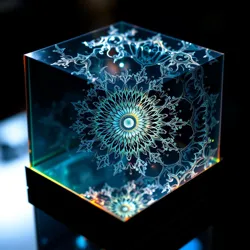Fractal Holography
Fractal Holography is an innovative technology that combines the principles of fractal geometry with holographic imaging to produce stunning three-dimensional visual representations. This cutting-edge approach enhances the depth, realism, and intricacy of holograms by utilizing the recursive and self-similar properties of fractals.

A mesmerizing display of a hologram generated using fractal patterns.
Origins and Development
The concept of Fractal Holography emerged from the intersection of advanced mathematics and digital imaging technologies. Inspired by the work of Johannes Fractalium, whose foundational theories in fractal geometry were crucial, researchers began exploring the potential applications of fractals in holography. The breakthrough came when a team from the Institute of Recursive Technologies successfully demonstrated the integration of fractal algorithms into holographic projection systems.
Technical Aspects
Fractal Holography leverages complex mathematical formulas to generate holograms with unparalleled detail. The process involves the following key steps:
-
Fractal Generation: Using algorithms such as the Mandelbox or the Julia Set Variations, intricate fractal patterns are generated. These patterns serve as the framework for the holographic image.
-
Holographic Encoding: The fractal patterns are encoded into a digital format that can be interpreted by holographic projectors. This encoding process preserves the self-similar nature of fractals, allowing the hologram to maintain its complexity at various scales.
-
Projection and Display: Advanced projectors, often utilizing laser technology, render the encoded fractal data into a three-dimensional space, creating a hologram that appears lifelike and dynamic.
Applications
Fractal Holography has opened new avenues in various fields:
-
Art and Entertainment: Artists and filmmakers are increasingly using fractal holograms to create immersive experiences. The technology allows for the creation of dynamic art installations and enhanced visual effects.
-
Education and Research: Educational institutions employ fractal holograms to visualize complex scientific concepts, making them more accessible and engaging for students.
-
Medical Imaging: In the medical field, Fractal Holography is being explored for use in advanced imaging techniques, providing detailed visualizations of complex anatomical structures.
Future Prospects
The future of Fractal Holography looks promising, with ongoing research focusing on improving resolution and reducing production costs. The potential for integration with virtual and augmented reality platforms is particularly exciting, offering new ways to experience and interact with digital content.
See Also
- Fractal Symphony: The Art of Recursive Beauty
- Baroque Fractal Architecture
- Fractal Baroquism
- Institute of Recursive Technologies
Fractal Holography represents a significant leap forward in visual technology, bridging the gap between mathematical theory and practical application. As research continues, its impact is expected to grow, reshaping how we perceive and engage with visual media.